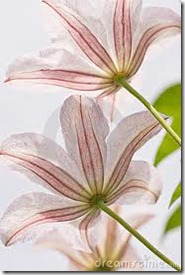Clematis number among the most spectacular flowering vines, producing more than 100 large, brightly colored blossoms each season, displayed on a bed of green foliage. Clematis vines grow between 2 and 30 feet long, depending on the cultivar. Horticulturalists recognize three types of clematis based on when their blossoms open: in the spring, summer or fall. Flowering time, in turn, determines when and how you prune your clematis. In order to determine the correct method to use, observe your clematis for a season to determine when it blooms. The bloom time tells you the type of clematis you have and determines the pruning method you should use.
- Difficulty:
- Moderately Easy
Instructions
things you’ll need:
- Pruning shears
- Hose or watering can
- Fertilizer
- Mulch
Spring-Blooming Clematis
- Identify these clematis when their blossoms open early in the spring, during April or May. Spring-blooming clematis produces flower buds in the fall, which survive over the winter, so pruning after bud formation in the winter or early spring will destroy the buds and result in no flowers.
- Trim away any shoots that bloomed this season after the plant finishes blooming. Do not prune spring-blooming clematis after July in order to give the plant time to recover before forming the next season’s buds.
- Trim back vines to control the shape and size of the plant. Select smaller, softer growth and avoid thick, woody vines.
- Water, fertilize and mulch the plant after pruning.
Large-Flower Clematis
- Identify these clematis when they blossom in mid-June. Like early-blooming clematis, they form flowers on the previous season’s growth, then produce a second round of blossoms later in the summer on new growth.
- Remove dead or weakened shoots in late winter or early spring. Keep the shoots with the largest and strongest-looking buds.
- Deadhead spent blossoms to encourage a second round of flowering. Alternately, you can cut the entire plant back to 12 to 18 inches. The second flowers will be smaller and appear in late summer.
- Water, fertilize and mulch the clematis after pruning.
Late-Blooming Clematis
- Identify late-blooming clematis when they begin blooming in mid-June and continue flowering into the fall. Late-blooming clematis produce blossoms on the current season’s growth, making them the easiest type to prune.
- Cut the entire plant back to 24 to 36 inches in height in early spring, removing all dead growth. Some late-blooming cultivars will add eight feet of new growth in a single season.
- Water, fertilize and mulch the plant after pruning.


Deprecated: strpos(): Passing null to parameter #1 ($haystack) of type string is deprecated in /home/agriviek8Qv/agriviet.net/public_html/wp-includes/comment-template.php on line 2522